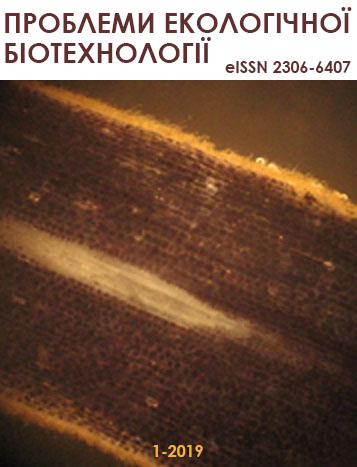Determination of the influence of the content of carbohydrates, phytohormones on growth of «hairy» roots and accumulation of flavonoids of medicinal plants Bidens pilosa and Artemisia tilesii
DOI:
https://doi.org/10.18372/2306-6407.1.13800Keywords:
«hairy» roots, roots, agrobacterial transformation, Agrobacterium rhizogenes, Artemisia tilesii, Bidens pilosa, flavonoidsAbstract
The effect of carbohydrates (sucrose, glucose) and phytohormones (indolyl butyric and gibberellic acids) on the weight gain of «hairy» roots and the accumulation of flavonoids in medicinal plants Bidens pilosa and Artemisia tilesii was studied. It was found that the addition of carbohydrates and phytohormones to Murashige and Skoog (½ MS) nutrient medium stimulated the growth of «hairy» roots and an increase in the content of flavors of A. tilesii, except for media with glucose. In the B. pilosa lines, stimulation of the growth and accumulation of flavonoids was observed only in the case of cultivation on a medium with 40 g/l of sucrose.References
Analgesic and antiinflammatory activities of the ethyl acetate fraction of Bidens pilosa (Asteraceae). / [Fotso A.F., Longo F, Djomeni P.D. et. al] // Inflammopharmacology. – 2014. – Vol. 22(2). – P. 105-14. – doi: 10.1007/s10787-013-0196-2
Hazra B. Antioxidant and free radical scavenging activity of Spondias pinnata/ В. Hazra, S.Biswas, N. Mandal // BMC Complementary and Alternative Medicine. – 2008. – P. 8–63. – doi: 10.1186/1472-6882-8-63.
Bartolome A. P. Effect of Rol Genes on Polyphenols Biosynthesis in Artemisia annua and Their Effect on Antioxidant and Cytotoxic Potential of the Plant Bidens pilosa L. (Asteraceae): Botanical Properties, Traditional Uses, Phytochemistry, and Pharmacology [Електронний ресурс]/ A.P. Bartolome, I.M. Villaseñor, W.C. Yang // Evid Based Complement Alternat Med. – 2013. – doi: 10.1155/2013/340215.
Matveeva T.V. Agrobacterium rhizogenes-Mediated Transformation of Plants for Improvement of Yields of Secondary Metabolites/ T. V. Matveeva S. V. Sokornova// Bioprocessing of Plant In Vitro Systems. – NY: Springer International Publishing, 2016. – P. 161–202. – DOI 10.1007/978-3-319-32004-5_18-1.
Остапчук А. Вивчення «бородатих» коренів Artemisia tilesii Ledeb. / А. Остапчук, Н. Матвєєва // Agrobiodiversity for improving nutrition, health and life quality – Nitra: Slovak University of Agriculutre, 2015. – P. 518–520.
Дробот К. О. Культура трансгенних коренів рослин роду Artemisia як джерело біологічно активних сполук: дис. канд. біолог. наук : 0 03.00.20/ Дробот Катерина Олександрівнва; МОН України, Інститут клітинної біології та генетичної інженерії НАН України. – Київ, 2018. – С. 183.
Матвєєва Н.А. Вплив зниженої температури на синтез флавоноїдів у культурах «бородатих» коренів Аrtemisia vulgaris та Аrtemisia annua / Н.А.Матвєєва, О.А.Гаврилюк, Л.С.Ястремська// Фактори експериментальної еволюції організмів: зб.наук.пр. – К: Укр. т-во генетиків і селекціонерів ім. М. Вавілова, 2018. – Т.23. – С. 302–307.
Murashige T. A revised medium for rapid growth and bio-assays with tobacco tissue cultures / T. Murashige, F. Skoog // Physiol Plant. – 1962. – Vol. 15(3) – C. 473–497.
Культура генетически трансформированных корней (hairy roots) Silene roemeri Friv – источник получения фитоэкдистероидов / [Эрст А.А., Зибарева Л.Н., Железниченко Т.В., Ковзунова О.В.] // Вестник Томского государственного университета. Биология. – 2017. – № 37. – С. 17–30.
Biotransformations of putative phytoecdysteroid biosynthetic precursors in tissue cultures of Polypodium vulgare / [Reixach N., R. Lafont, F. Camps, J. Casas] // European Journal of Biochemistry. – 1999. – Vol. 266. – P. 608–615.
Flavonoids are determinants of freezing tolerance and cold acclimation in Arabidopsis thaliana / [Schulz E., Tohge T., Zuther E. et. al] – [Eлeктpoнний peсуpс] – // Sci. Rep. – 2016. – Vol. 6. – No. 34027. – doi: 10.1038/srep34027.
Influence of cold stress on growth and flavonoids аccumulation in Artemisia tilesii «hairy» root culture / [Havryliuk O., Мatvieieva N., Tashyrev O., Yastremskaya L.] // Agrobiodiversity. – 2017. – №1. – Р. 163–167. – DOI:10.15414/agrobiodiversity. 2017.2585-8246.163-167.


